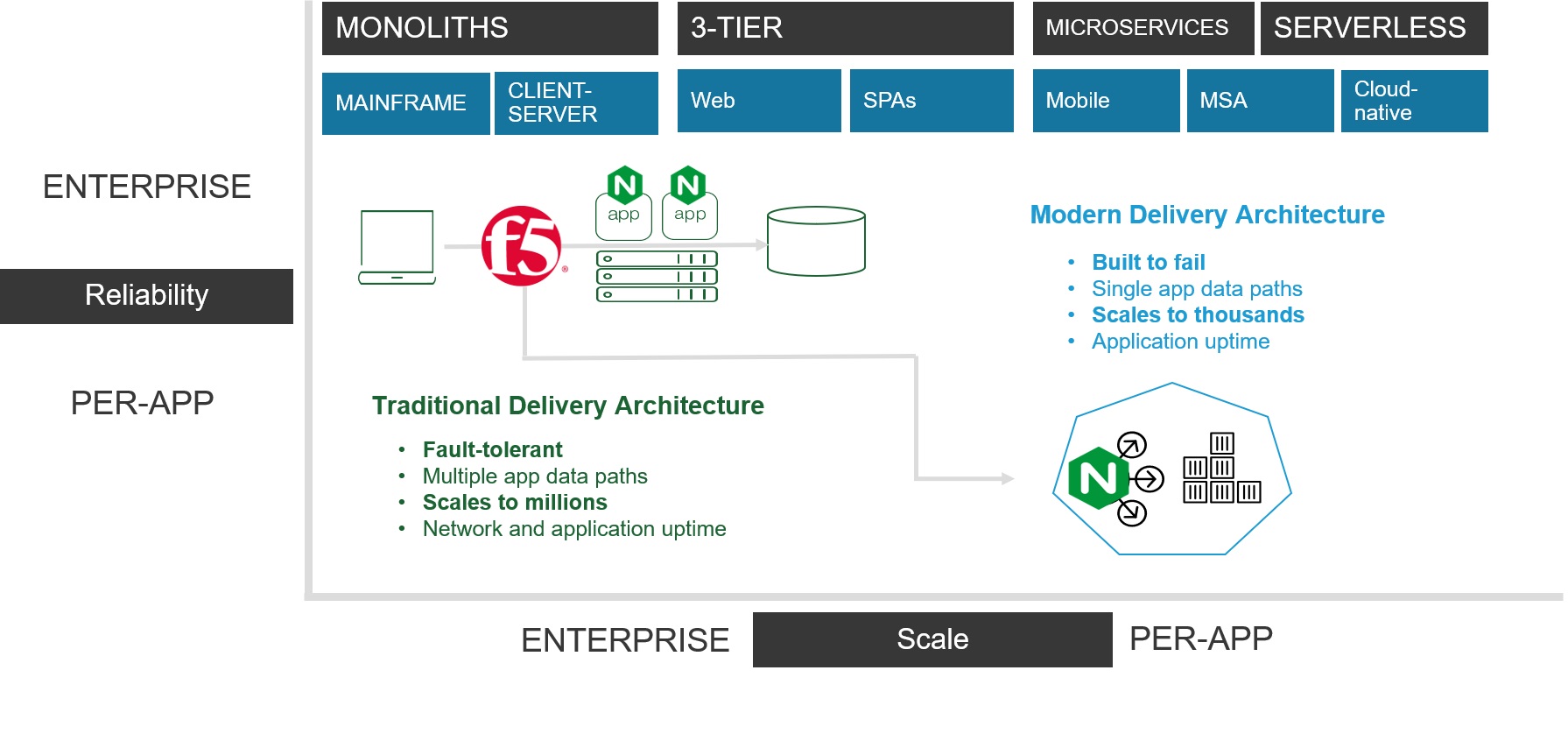隔たりを埋める: スケールと信頼性
生産は失敗するように構築されているわけではありません。
従来のネットワークおよびアプリケーション サービスのアーキテクチャは、障害が発生した場合でも信頼性が維持されるように構築されています。 冗長性とフェイルオーバーは、顧客と組織の最も貴重な資産であるアプリケーションの間に位置するインフラストラクチャの重要な機能です。
フェイルオーバー (真のフェイルオーバー) は、単に新しいコンテナを起動するだけでは実現できません。 このアプローチは、ステートレスになるように設計された最新のアプリケーションでのみ機能します。 これは従来のアプリケーションではめったに見られない特徴であり、現代のアプリケーションでも確実ではありません。 エンタープライズ クラスのスケールと信頼性は、エンタープライズ アプリケーション ポートフォリオの大部分を占める従来のアプリの可用性を維持するために不可欠です。
しかし、だからといって、増え続ける最新アプリケーションを無視すべきだというわけではありません。 すべての新しいアプリ アーキテクチャは、ほんの数個のプロジェクトから始まり、組織がそれらの新しいアプリを拡張および保護するために必要なシステムとソリューションを開発、展開、運用する方法を学習するにつれて、爆発的に増加します。 企業内で最新のアーキテクチャを使用して開発されるまったく新しいアプリケーションの数は依然として少ないですが、急速に増加しています。 組織がデジタル経済に追いつこうとするなら、そうしなければなりません。
アプリケーションのスピードに合わせたアーキテクチャ
現在、5 社に 1 社以上の組織で、アプリケーション バックログに 50 件以上の主要なアプリケーション リクエストが存在します。 61% 以上で、キューに 10 件を超える新しいアプリ リクエストがあります。 従来の開発アプローチでは対応できません。 組織が配信を加速するためにアジャイルとマイクロサービスを採用するにつれて、最新のアーキテクチャに基づくアプリがさらに多く登場するでしょう。
そして、そうするにつれて、最新のアーキテクチャのスケールと信頼性のモデルと、エンタープライズ レベルの展開を実現するために必要な厳しいスケールと信頼性との間の溝を埋める方法が必要になります。
こうした最新のアーキテクチャには、多くの場合、NGINX が含まれています。実際、新興の最新アーキテクチャのほとんどは、1 つ以上の役割で NGINX に依存していると言っても過言ではありません。
コンテナで実行されている上位 12 のアプリケーション コンポーネントの 1 つに NGINX があります。使用されているコンテナ イングレス プロバイダーのトップ (正直に言うと、トップ)に NGINX があります。クラウド、コンテナ、マイクロサービスに関するすべての調査とデータに基づくレポートでは、実行中のコンポーネントのリストに NGINX が含まれている可能性があります。
NGINX は主に、最新のアーキテクチャにおけるスケールのニーズに応えます。 1 つのアプリ インスタンスに障害が発生した場合、NGINX がそれを検知して後続のリクエストを他のアプリ インスタンスに転送するため、最新のアプリに信頼性がもたらされます。 コンテナ環境に本質的に設計されている障害をカバーします。 また、ほとんどの DevOps と開発者が満たす必要のあるアプリケーションの稼働時間の要件も満たします。
しかし、それは必ずしもエンタープライズ アーキテクチャ全体を拡張し、その信頼性を確保することにはつながりません。 最新のアプリケーションで非常にうまく機能する「故障を前提に構築された」システムは、従来のアプリやアプリケーション サービス インフラストラクチャに同じ機能を提供するのには適していません。 違いの核心は、「状態モデルとステートフル モデル」です。 最新のアプリはステートレスであることを目指しています。ステートレスであることで、アーキテクチャが機能するからです。 従来のアプリ、そしてネットワーク自体はステートフルです。 障害が発生すると、進行中のトランザクションとセッションが終了し、可用性が損なわれます。
現代の信頼性
運用中の障害が共有インフラストラクチャ(その大部分)に影響を与える場合、その影響範囲は大きくなります。 とても大きいです。 何百ものアプリケーションの配信とセキュリティを担うネットワークとアプリケーション サービスは、障害が発生するように構築されているのではなく、信頼性を確保するために構築されています。
エンタープライズクラスのスケールと信頼性を実現するのは、BIG-IP を搭載した F5 です。 信頼性を重視して設計され、需要と大規模な攻撃の両方に対応できるように拡張可能な BIG-IP は、25,000 を超える企業がアプリケーションを配信する手段となっています。 これは、NetOps が満たすべきネットワークとアプリケーションの稼働時間の要件を満たします。

これら 2 つを組み合わせることで、定義に関係なく「信頼性」の要件を満たすことができます。 それが、最新のアプリを拡張する小規模な開発者主導のデプロイメントの信頼性に当てはまるか、アプリケーション サービスと従来のアプリを同様に拡張する大規模なデプロイメントに当てはまるかにかかわらず、統合されたポートフォリオにより、顧客は適切なアプリに適切なツールを使用できるようになります。
F5 と NGINX を組み合わせることの利点の詳細については、F5 の CEO による「Bridging the Divide」ブログ シリーズを紹介する投稿をご覧ください。
